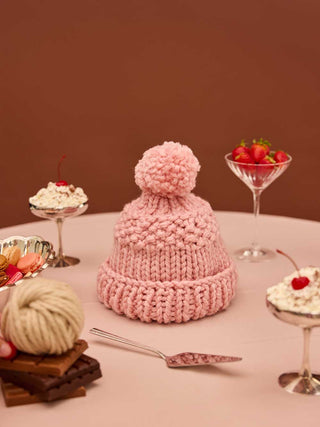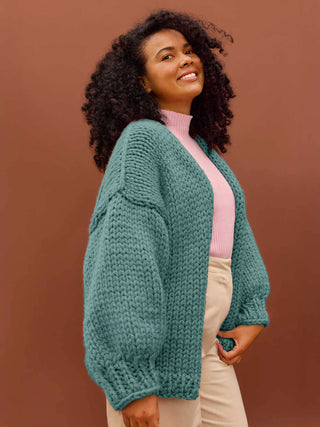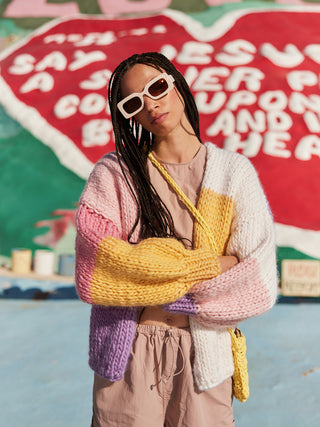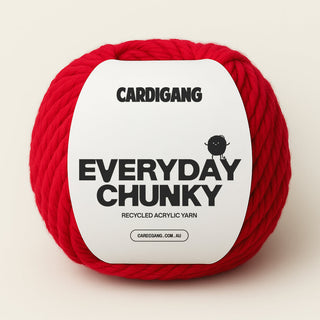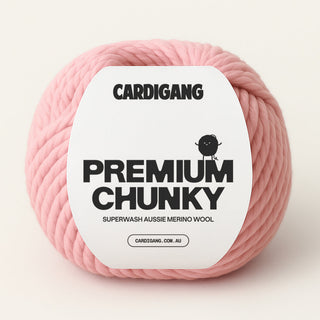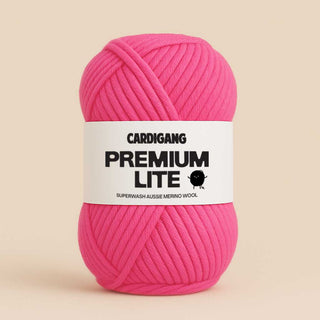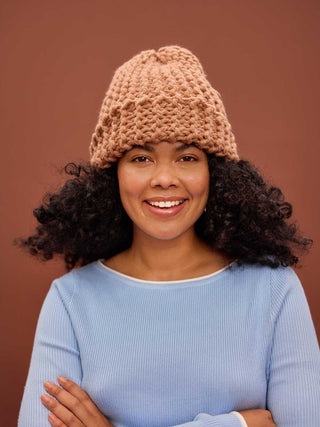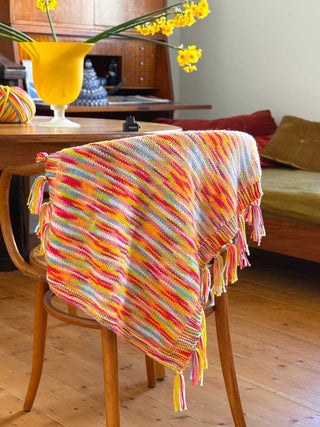A step by step guide to knitting the beautiful Emily.
Ever gotten half way through a project and thought “Hang on, am I even doing this right?”
We have 🙋♀️
That’s why we’ve created these step by step overviews to help guide you through the knitting process.
At each stage we’ll show you how each section your jumper should look, and at the end, how to sew it all together. Voilà! We’ve also included videos below covering the main techniques and stitches. So head on down to the bottom of the page if you just need a quick visual reference.
THE EMILY JUMPER
Emily's an all-rounder and the perfect match for almost any occasion. She rocks a loose, oversized shape with a seed stitch body and colour blocked arms.
YOUR CARDIGANG PATTERN
Learning to knit can feel like learning code. We've stripped away the complicated jargon and tried to keep things really simple. If your head is still spinning a little, here's a handy video to help you better understand the layout of your pattern.
TEST YOUR TENSION
Before we dive in let's check that the tension is in line with what we need. We knit a swatch to make sure the tension is juuuust right. It's a bit like goldilocks, if the tension is too tight, your jumper will be too small, and if it's too loose it may not hold it's shape and might be too big.
If done correctly, your 10x10cm swatch should knit 6 stitches and 9 rows.
THE BASICS
Before we get started, learn all the basics with our how to video. This one covers Casting on, 1x1 Rib stitch, Knit stitch, Purl stitch and Casting off. Once you've got these mastered you'll find this pattern is a cinch!
ONTO THE JUMPER!
BACK
Okay guys, so we start with the back panel, it’s the simplest piece of the jumper and will give you the confidence as you move onto other pieces.
We knit from the bottom up.
First, we cast the required number of stitches using colour 1 and our 15mm needles. We recommend using the two needle technique. Two needle knit cast on uses your two needles (surprise!), starting with a slip knot on your left needle, each stitch is knitted to form a new loop and this loop is then added to your left needle. You repeat until you’ve made the desired number of stitches.
💡 Casting on, like many things in knitting, can be done in a number of ways - our suggestion is a simple technique but you can pick any that’s right for you.
Once you've cast on the right number of stitches you move on to the 4 rows of seed stitch.
Seed Stitch is a common, easy stitch pattern in knitting. It is made by alternating knit stitches and purl stitches within a row and between rows. It is called seed stitch because the stitches create little bumps that may look like seeds. Seed stitch is identical on both sides and lies flat.
After you've completed the 4 rows we're going to change to colour 2. To change colours you simple start knitting the new row with the new yarn ball. You can tie the tails at the start of the row to keep your work tight. Then continue knitting in seed stitch for the allocated rows.
Simple right?! 😎
Once you've completed your rows you need to cast off all your stitches. To cast off, knit two stitches then slip the first stitch on your right needle back over the second stitch and off the needle. You’ll have one stitch left on your right needle. Knit another stitch so you’ve got two stitches on your right needle and then slip the first stitch off. Continue to the end of the row. When you’ve got the last stitch on your right needle, cut the yarn and thread this through the final stitch to secure.
FRONT
Now onto the front. It’s basically a repeat of the back until we get up to the neckline.
Now the neck is where it can get a little tricky because we split the shoulders from the neck and we cast off a bunch of stitches in the middle for the neckline hole.
Just remember you knit all the rows to complete one shoulder before you move onto the next. It will seem a little weird on the first shoulder because you’ve got all the extra stitches sitting on your needle but that’s totally correct.
Just remember, you get the seed stitch pattern when you knit your purl stitches and purl your knit stitches. So as you're knitting the neckline, make sure you pay attention to that to ensure you maintain that lovely pattern.
ARMS
Okay, onto the arms! You'll need two of these! 😝
Now the arms are knitted in stockinette stitch using our 15cm needles, we start from the top of the arm and work down. We knit this piece flat just like the front and back.
Stockinette Stitch (or stocking stitch) is a basic stitch that most knitting patterns often don't explain! You create stockinette stitch by knitting one row and purling the next. This means all of your knit stitches (the little Vs) will be on the right side of your jumper.
Once we've finished the allocated amount of rows, we're going to decrease our stitches for a row before we knit the ribbed cuff.
To get that statement balloon sleeve we decrease the width of the sleeve by purling two stitches together all the way to the end of the row. It's really easy, you just pick up 2 stitches with your right needle instead of the normal one, and then purl the stitches as you normally would.
Once that’s done you swap to the 10cm needles and start your rib stitch.
💡 To switch to a different size needle we just hold the new needle in our right hand and knit onto it.
1x1 Rib Stitch is a textured pattern usually used on the cuffs and necks of jumpers. It’s made by alternating knit and purl stitches in the same row, then knitting the same stitch in the next row. When doing your rib stitch it’s important to make sure your yarn is on the correct side of your needles (at the back for knit stitches and at the front for purl stitches.)
💡 When you cast off make sure it’s not too tight otherwise you’ll have a really tight wrist hole.
SEWING IT TOGETHER
Now it’s time to get to work with the darning needle to sew your masterpiece together. We lay our pieces flat and sew them together one by one.
Step 1: lay your front and back pieces on a flat surface, the right sides facing you.
Step 2: Sew the shoulder panels together using the invisible seam technique, and leaving the hole for your head.
Step 3: Time to attach the sleeves to the body. Make sure the middle of your sleeve is lined up with the shoulder seam. This will ensure the seam of your sleeve is right under your armpit, not half way around your arm! Once you've made sure it's all lined up, sew the sleeves to the shoulders.
Step 4: Fold your jumper in half so it looks like the shape of a T. With the wrong sides facing each other, we're going to sew it together using a Mattress Stitch, from the cuff all the way up the arm to the arm pit, then down the side seam to the bottom of your jumper. And then repeat this on the other side.
💡 We suggest trying to match the colour yarn you use to the jumper to keep it as invisible as possible. It's normal for the wool to get a bit shabby as you go, so we recommend using a few pieces and tying them together underneath as you go!
We've included handy videos below for both the invisible seam and mattress stitch.
THE NECK
Okay guys almost done!!! The last part is the neck. We knit the neck ‘in the round’. This means we use the circular needles instead of knitting back and forth on a row.
The neck is kitted in 1x1 rib stitch - you’ll be pretty good at this now!
So first things first. We pick up 40 (44, 46) stitches in equal distance from around the neck hole. There are a few different ways to do this but we’ve included a video of our fav technique below. Once you’ve got all your stitches on your needle you join the loop together and start the rib stitch. It’s a good idea to loop a hair tie or spare piece of yarn over your needle when you start so you can keep track of each loop.
Knit in the round until you’ve completed 5 loops then cast off.
💡 Now this part is critical! Cast of extra loosely!! You need a loose cast off in order to be able to fit your head through the hole. Rib stitch has a stretch to it, but if you cast off too tightly you'll have a hole that's too small for your head to fit through. Been there, done that and DON'T recommend 😝
The last thing we do for every piece is weave in the ends. That’s basically just tidying up the piece so all loose ends are trimmed down and tucked in.
VIDEOS FOR A BIT OF EXTRA HELP!
Don't worry, YouTube was our best friend when we taught ourselves how to knit.
Here are some videos that should be helpful but feel free to go searching for your own. There are a number of techniques people use for a lot of the common stitches in knitting so there's no one right way.
Find what works for you! If you get stuck, reach out to us and we'll give you a hand! 😎
Testing your gauge
Casting On
Knit Stitch
Purl Stitch
1x1 Rib Stitch
Stockinette Stitch
Decrease a stitch
Casting Off
Changing colours
Sewing together
Neckline


